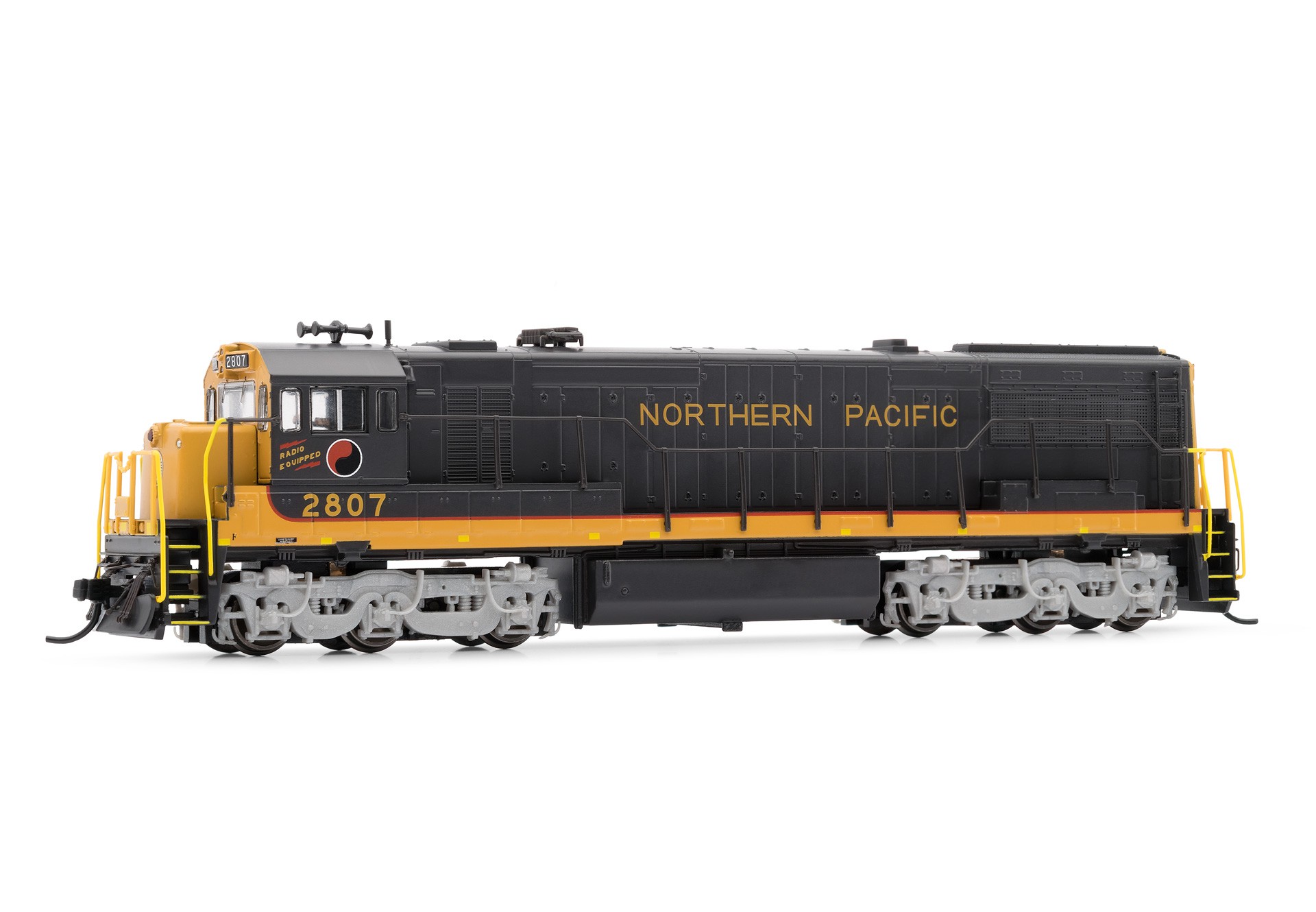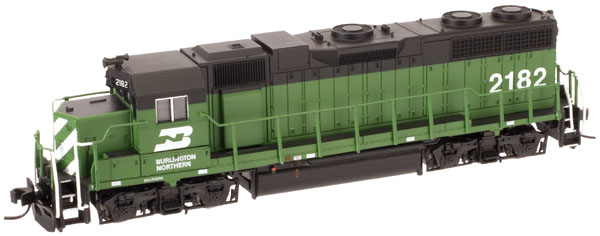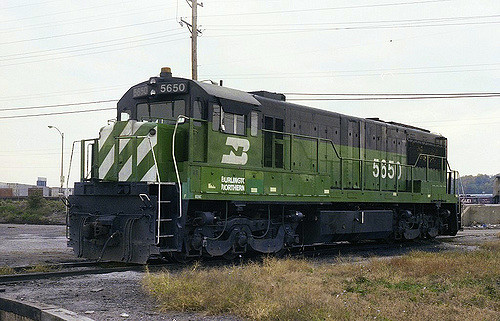Model Information: The Arnold/Hornby GE U25C was released in 2015. They later released the U28C in 2016.
This is a beautiful model with terrific paint and detailing. The lighting scheme is amazing. The model performs excellently, running smoothly and quietly at all speeds, and able to pull 40+ 40' cars without an issue. It uses a 5-pole skew-wound motor with dual flywheels. It also features a very innovative lighting scheme which is quiet cool with constant lighting of the number boards and directional lighting on the head and tail lights.
On the less positive side, as with many other N Scale 6-axle locomotives, the minimum turning radius is 11". Also, the tiny handrails are a bit fragile. To remove the shell, one must unscrew and remove the couplers (which must be handled carefully, or they may fall apart). Overall, this is an excellent model.
On the less positive side, as with many other N Scale 6-axle locomotives, the minimum turning radius is 11". Also, the tiny handrails are a bit fragile. To remove the shell, one must unscrew and remove the couplers (which must be handled carefully, or they may fall apart). Overall, this is an excellent model.
DCC Information: It is DCC Ready, configured to accept standard NMRA 6-pin (NEM 651) decoder.
Prototype History: The U28C was developed by General Electric from the U25C, with a slight increase in power of 300 hp (224 kW).[2] A passenger-hauling variant, the U28CG, was also produced for the Atchison, Topeka and Santa Fe Railway.
General Electric built ten uprated U25Cs in 1965. Facing the competitive pressure of the second generation horsepower race, GE built these units with increased horsepower. The competitive 2750 horsepower Alco C628 had more horsepower and the 3000 horsepower Alco C630 was announced in July 1965. General Motors had the 3000 horsepower EMD SD40 demonstrators testing on several railroads. The increase in unit horsepower was happening that year. The uprated units were built for three railroads that were already operating the U25C. The first uprated units were built for the Northern Pacific between May and July 1965. These were NP #2518-2520 and were rated at 2750 horsepower. Three more uprated U25Cs were built as Atlantic Coast Line #3011-3013 in December 1965. The ACL units were rated at 2800 horsepower. The last four uprated U25Cs were rated at 2800 horsepower and were built for the Pennsylvania Railroad in December 1965. These were PRR #6516-6519. Six additional PRR U25Cs were uprated to 2800 horsepower: 6500-6503, 6510-6511. In early 1966 General Electric began offering the 2800 horsepower U28C. A total of 28 look-a-like U28Cs were built between February 1966 and July 1966 as Chicago Burlington and Quincy #562-577 and Northern Pacific #2800-2811. These early Phase I U28Cs shared the 64 foot 4 inch frame that was standard with the predecessor U25C.
A drawing of the proposed longer frame U28C is in the November 1965 issue of Trains Magazine. Starting in May 1966 GE began producing the U28C on a longer frame. The new length for these U28Cs was 67 feet 3 inches. These are the 43 Phase II units built for Louisville and Nashville, Pennsylvania, Southern Pacific and Union Pacific. The Phase II units used either the General Electric GT 598 Generator or the GTA 9 Alternator. The 10 Santa Fe U28CGs were also built on this longer frame. Starting in November 1966 and through mid 1967 GE built 24 look a like Phase I U30Cs that used the same carbody as the Phase II U28Cs.
General Electric built ten uprated U25Cs in 1965. Facing the competitive pressure of the second generation horsepower race, GE built these units with increased horsepower. The competitive 2750 horsepower Alco C628 had more horsepower and the 3000 horsepower Alco C630 was announced in July 1965. General Motors had the 3000 horsepower EMD SD40 demonstrators testing on several railroads. The increase in unit horsepower was happening that year. The uprated units were built for three railroads that were already operating the U25C. The first uprated units were built for the Northern Pacific between May and July 1965. These were NP #2518-2520 and were rated at 2750 horsepower. Three more uprated U25Cs were built as Atlantic Coast Line #3011-3013 in December 1965. The ACL units were rated at 2800 horsepower. The last four uprated U25Cs were rated at 2800 horsepower and were built for the Pennsylvania Railroad in December 1965. These were PRR #6516-6519. Six additional PRR U25Cs were uprated to 2800 horsepower: 6500-6503, 6510-6511. In early 1966 General Electric began offering the 2800 horsepower U28C. A total of 28 look-a-like U28Cs were built between February 1966 and July 1966 as Chicago Burlington and Quincy #562-577 and Northern Pacific #2800-2811. These early Phase I U28Cs shared the 64 foot 4 inch frame that was standard with the predecessor U25C.
A drawing of the proposed longer frame U28C is in the November 1965 issue of Trains Magazine. Starting in May 1966 GE began producing the U28C on a longer frame. The new length for these U28Cs was 67 feet 3 inches. These are the 43 Phase II units built for Louisville and Nashville, Pennsylvania, Southern Pacific and Union Pacific. The Phase II units used either the General Electric GT 598 Generator or the GTA 9 Alternator. The 10 Santa Fe U28CGs were also built on this longer frame. Starting in November 1966 and through mid 1967 GE built 24 look a like Phase I U30Cs that used the same carbody as the Phase II U28Cs.
Road Name History:  The Northern Pacific Railway (reporting mark NP) was a transcontinental railroad that operated across the northern tier of the western United States from Minnesota to the Pacific Coast. It was approved by Congress in 1864 and given nearly 40 million acres (160,000 km2) of land grants, which it used to raise money in Europe for construction. Construction began in 1870 and the main line opened all the way from the Great Lakes to the Pacific when former president Ulysses S. Grant drove in the final "golden spike" in western Montana on Sept. 8, 1883.
The Northern Pacific Railway (reporting mark NP) was a transcontinental railroad that operated across the northern tier of the western United States from Minnesota to the Pacific Coast. It was approved by Congress in 1864 and given nearly 40 million acres (160,000 km2) of land grants, which it used to raise money in Europe for construction. Construction began in 1870 and the main line opened all the way from the Great Lakes to the Pacific when former president Ulysses S. Grant drove in the final "golden spike" in western Montana on Sept. 8, 1883.
The railroad had about 6800 miles of track and served a large area, including extensive trackage in the states of Idaho, Minnesota, Montana, North Dakota, Oregon, Washington and Wisconsin. In addition the company had an international branch to Winnipeg, Manitoba, Canada. The main activities were shipping wheat and other farm products, cattle, timber and minerals; bringing in consumer goods, transporting passengers; and selling land.
The company was headquartered first in Brainerd, Minnesota, then in Saint Paul, Minnesota. It had a tumultuous financial history, and in 1970 it merged with other lines to form the Burlington Northern Railroad.
Read more on Wikipedia.

The railroad had about 6800 miles of track and served a large area, including extensive trackage in the states of Idaho, Minnesota, Montana, North Dakota, Oregon, Washington and Wisconsin. In addition the company had an international branch to Winnipeg, Manitoba, Canada. The main activities were shipping wheat and other farm products, cattle, timber and minerals; bringing in consumer goods, transporting passengers; and selling land.
The company was headquartered first in Brainerd, Minnesota, then in Saint Paul, Minnesota. It had a tumultuous financial history, and in 1970 it merged with other lines to form the Burlington Northern Railroad.
Read more on Wikipedia.
Brand/Importer Information: Founded in 1906 by Karl Arnold in Nürnberg, K. Arnold & Co. began its life producing tin toys and related items. They produced an extensive line of model ships, doll house items and other toys. In 1935, K. Arnold & Co. hired Max Ernst as their managing director. Ernst, not to be confused with the German realist artist of the same name, was a significant factor in the future of Arnold.
On Max Ernst's 1976 retirement, Arnold employed perhaps 200 to 250 people, using three facilities in the Nuernberg area. The Company continued under family control until 1995, when Arnold went into bankruptcy and was sold to Rivarossi of Italy. Rivarossi, in turn, also went bankrupt, leading to the sale of all assets to Hornby of the United Kingdom. Production is carried out in China.
From Wikipedia
On Max Ernst's 1976 retirement, Arnold employed perhaps 200 to 250 people, using three facilities in the Nuernberg area. The Company continued under family control until 1995, when Arnold went into bankruptcy and was sold to Rivarossi of Italy. Rivarossi, in turn, also went bankrupt, leading to the sale of all assets to Hornby of the United Kingdom. Production is carried out in China.
From Wikipedia
Item created by: gdm on 2016-08-22 21:23:37. Last edited by Alain LM on 2020-10-25 12:09:10
If you see errors or missing data in this entry, please feel free to log in and edit it. Anyone with a Gmail account can log in instantly.
If you see errors or missing data in this entry, please feel free to log in and edit it. Anyone with a Gmail account can log in instantly.










